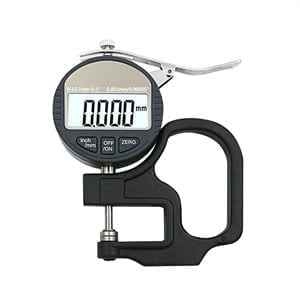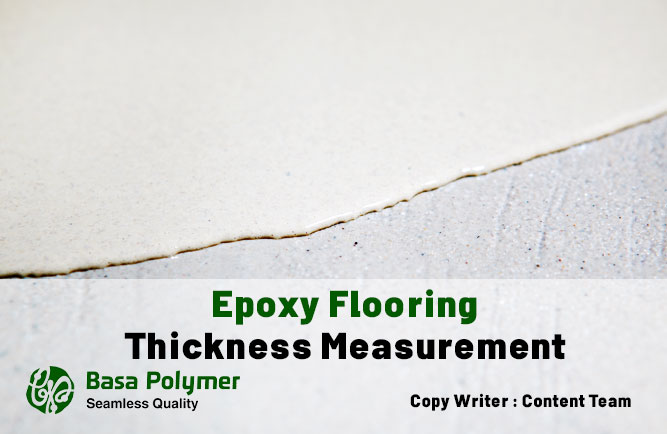All those who are somehow active in the field of resin flooring (selling flooring material, providing flooring installation services, interior designers and interior decoration, end users of flooring, etc.) are somehow involved in determining the appropriate thickness of the flooring and installing the flooring in its appropriate thickness.
But what is the standard thickness of resin flooring and how is it determined? The determination of this thickness depends on what factors?
Epoxy Flooring Thickness and its measurement method
How can we measure the thickness of resin flooring and floor coverings? These questions are answered in this article.
The thickness of the coatings is divided into two categories: wet thickness and dry thickness.
1- Wet film thickness of Epoxy Flooring:
As you know, all types of resin flooring are delivered to the customer in two or three parts and in liquid form. The flooring executive or the flooring installation contractor prepares the resin flooring material and will install the flooring or floor covering in the desired location according to the flooring installation instructions.
Therefore, at the time of starting the installation of resin flooring, the material is in a liquid state, and due to the chemical reaction, that begins after mixing the components, it turns into a solid state and creates a solid and seamless surface. Based on this, wet thickness refers to the thickness of the floor covering at the time of its installation, which is still liquid.
2- Dry film thickness of Resin Flooring:
After curing the installed floor covering, the term dry film thickness is used. It is noteworthy that due to different drying mechanisms, which in some cases are accompanied by the shrinkage of the flooring, as well as the formulation of the desired floor covering (presence of volatile organic substances in the formulation), the wet film thickness is usually greater than the dry film Flooring Thickness.
*In this article, wherever thickness is mentioned, it means the dry film thickness of the coating or resin flooring.
Based on the classification made in international standards, resin floors are divided into 8 different categories based on thickness.
Generally, the types that have less number of layers and therefore less thickness (less than 1 mm) are called floor coatings, and the types that have more layers and higher thicknesses are called flooring. Floor coverings are used to seal the surface and prevent the creation of dust in the environment for light and medium uses (people’s traffic, wheelbarrows, etc.).
While resin floors (thickness 1 to +6 mm) are recommended for heavy and extra heavy usage (heavy machines, falling heavy objects, high traffic, etc.). Therefore, it can be concluded that the thickness of epoxy flooring is a function of its final use.
The standard method of determining the thickness of the floor:
As mentioned earlier, the thickness of the flooring is a function of its final use. In addition to the usage, the condition and type of the substrate (concrete, stone, etc.) and the final design of the flooring are also effective on the minimum acceptable thickness of the flooring.
But in general, by estimating the amount of force applied to the flooring, it is calculated based on its compressive strength. In these calculations, the thickness of the flooring should be calculated in such a way that the force transmitted through the flooring to the concrete (or other types of substrates) is less than its compressive strength.
If the thickness of the flooring is less than this calculated thickness, the transfer of more force than the strength of the concrete will lead to the failure of the subfloor and eventually, the flooring itself will crack. Therefore, the effective factors in determining the thickness of resin flooring at the time of purchase are:
1- Terms of use:
The type of traffic on the epoxy floor surface and its amount
2- Infrastructure conditions:
Depending on the type of resin flooring substrate (concrete, stone, mosaic, ceramic, etc.), the method of preparing the substrate surface for installing and implementing epoxy flooring is different, and if the substrate needs to be repaired, the material used from epoxy flooring (or other types of resin flooring) ) will increase.
3- Chemicals in contact with the flooring surface:
The type of chemicals used in the desired application that may come into contact with the flooring surface, its concentration, and the time it stays on the flooring surface determines the type of resin flooring required (in terms of its resin type) and the thickness of the flooring.
4- The final floor plan:
According to the final finish of the flooring surface (polished or orange peel), the choice of special flooring designs (cloud and wind and metallic flooring design, color flake flooring design) the consumption of flooring material will change.
The method of measuring the thickness of flooring:
Since part of the applied epoxy material penetrates the substrate and it is not possible to visually estimate the thickness of the flooring, one of the constant concerns of buyers of epoxy flooring is to ensure that the thickness of the applied flooring matches the thickness declared by the flooring manufacturer. The following methods can be used to measure the thickness and ensure the compliance of the installed flooring specifications with the requested flooring:
1- Monitoring the amount of material used during the installation of flooring:
At the time of sending the flooring material to its installation location, it is determined by weighing the volume of the sent material. By referring to the technical data sheet of the purchased product, the two main characteristics that determine the thickness, i.e.
the density of the mixture and the percentage of volatile organic materials can be estimated to estimate the thickness of the dry film resulting from the application of this product on the floor.
If the estimated thickness matches the desired thickness, in the stages of flooring installation, through monitoring the work of the flooring contractor, and the complete consumption of the material with a good approximation, it is possible to ensure that the desired thickness is achieved.
2- Measuring the thickness of the installed flooring:
The method of measuring the thickness of the flooring after finishing the installation is a destructive test. In this method, by probing the floor and sending the samples to the laboratory, the thickness of the executive flooring is measured with a micrometer. Considering the destructiveness of this test, it is suggested to have an estimate of the applied thickness of the flooring (wet thickness) by checking the number of materials used during the installation of the flooring.



